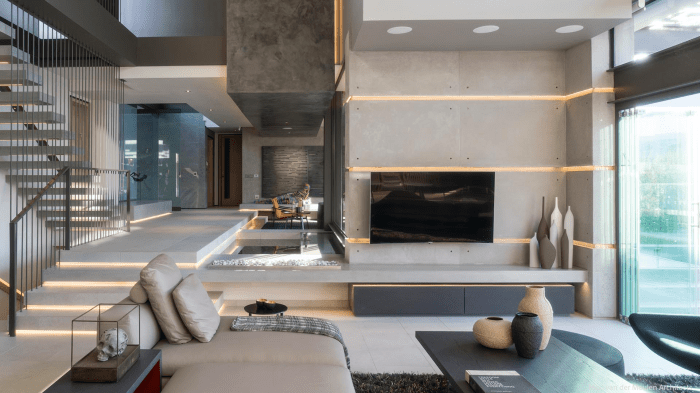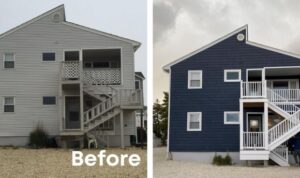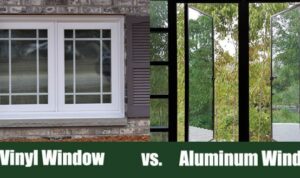Embark on a journey through the captivating world of architecture and interior design, where creativity meets functionality to shape our living spaces. From modern sleek designs to traditional charm, the interplay between architectural styles and interior aesthetics is a fascinating realm waiting to be explored.
Delve deeper into the fundamental elements that define architectural and interior design choices, uncovering the intricate balance between form, function, and visual appeal.
Architecture and Interior Design Styles
When it comes to architecture and interior design, there are various styles that define the overall look and feel of a space. From modern and minimalist to traditional and eclectic, each style has its unique characteristics that set it apart.
The choice of architectural style often dictates the interior design approach, creating a harmonious and cohesive living or working environment.
Modern Style
The modern architectural style is characterized by clean lines, simple forms, and a focus on functionality. Interiors are often spacious and open, with an emphasis on natural light and a neutral color palette. Furniture and decor in modern spaces are sleek and minimalistic, with an emphasis on geometric shapes and contemporary materials like glass, metal, and concrete.
Minimalist Style
Minimalist architecture and interior design focus on simplicity, where less is more. Clean lines, uncluttered spaces, and a limited color palette are key features of this style. Furniture and decor are often sleek and understated, with an emphasis on functionality and quality craftsmanship.
Minimalist spaces create a sense of calm and tranquility, promoting a clutter-free and peaceful environment.
Traditional Style
Traditional architecture and interior design draw inspiration from classic European styles, with a focus on symmetry, ornate detailing, and rich colors. Interiors are often formal and elegant, with plush furnishings, intricate moldings, and decorative accents. Traditional spaces exude a sense of warmth and sophistication, creating a timeless and inviting atmosphere.
Eclectic Style
Eclectic design combines elements from various styles and eras, creating a unique and personalized look. Mixing different textures, patterns, and colors is key to achieving an eclectic aesthetic. Furniture and decor in eclectic spaces are often a mix of vintage and modern pieces, creating a visually dynamic and eclectic environment.
Eclectic interiors reflect the homeowner's personality and style, showcasing a diverse range of influences and tastes.
Elements of Architecture and Interior Design

Architecture and interior design are both influenced by a variety of key elements that play a crucial role in shaping the overall look and feel of a space.
Key Elements in Architectural Design
Architectural design encompasses various elements that contribute to the overall structure and aesthetics of a building. Some key elements include:
- Form: The overall shape and structure of the building, including the layout of rooms and spaces.
- Function: How the building is intended to be used and how well it fulfills its purpose.
- Materials: The choice of materials used in construction, which can impact the durability, aesthetics, and sustainability of the building.
- Site: The location of the building and how it interacts with its surroundings, taking into account factors like climate, topography, and vegetation.
- Style: The architectural style or design language employed, which can range from traditional to modern and can influence the overall look and feel of the building.
Essential Elements in Interior Design
Interior design focuses on creating functional and aesthetically pleasing interior spaces. Some essential elements in interior design include:
- Lighting: Proper lighting can enhance the mood, atmosphere, and functionality of a space.
- Color Schemes: The choice of colors for walls, furniture, and decor can impact the overall look and feel of a room.
- Furniture Layout: The arrangement of furniture in a space to optimize functionality and flow.
- Texture: The tactile quality of surfaces like fabrics, wood, or metal that adds depth and visual interest to a room.
- Accessories: Decorative elements like artwork, rugs, and plants that add personality and style to a space.
Architectural elements such as form, materials, and style can greatly influence interior design choices. For example, a building with a modern and minimalist architectural style may call for a clean and simple interior design aesthetic with sleek furniture and a neutral color palette.
On the other hand, a building with a traditional architectural style might inspire a more classic and ornate interior design scheme with rich colors and textures
Sustainable Architecture and Eco-Friendly Interior Design
Sustainable architecture and eco-friendly interior design are crucial aspects of creating a more environmentally conscious and efficient built environment. By incorporating sustainable practices, we can reduce the negative impact of construction and design on the planet, while also creating healthier spaces for occupants.
Green Building Materials
Using green building materials is a key component of sustainable architecture. These materials are environmentally friendly, energy-efficient, and often have a lower carbon footprint compared to traditional materials. Examples of green building materials include recycled steel, bamboo, reclaimed wood, and low VOC paints.
Energy Efficiency
Energy efficiency is another important factor in sustainable architecture. By designing buildings that are energy-efficient, we can reduce energy consumption and minimize the use of fossil fuels. Strategies for improving energy efficiency include proper insulation, passive solar design, and the use of energy-efficient appliances and lighting.
Biophilic Design
Biophilic design is a concept in eco-friendly interior design that seeks to connect people with nature within the built environment. This can be achieved through the use of natural materials, indoor plants, natural light, and views of nature. Biophilic design has been shown to reduce stress, improve cognitive function, and enhance overall well-being.
Upcycling
Upcycling is a sustainable practice in interior design that involves repurposing old or discarded materials to create new and unique pieces. This not only reduces waste but also adds character and individuality to a space. Upcycling can include turning old pallets into furniture, using reclaimed wood for accent walls, or repurposing vintage items as decor.
Importance of Sustainability
Sustainability is crucial in both architecture and interior design to minimize environmental impact, conserve resources, and create healthier living and working environments. By prioritizing sustainability, we can build a more resilient and sustainable future for generations to come.
Cultural Influences on Architecture and Interior Design
Culture plays a significant role in shaping architectural styles and interior design aesthetics. The values, beliefs, traditions, and lifestyle of a particular culture often influence design choices, resulting in unique and diverse architectural and interior design elements.
Influence of Different Cultures on Design Choices
Various cultures around the world have left their mark on architecture and interior design, showcasing a blend of tradition and innovation. Here are some examples of how different cultures influence design choices:
- Japanese Influence: Japanese architecture is known for its minimalism, natural materials, and harmony with nature. This influence can be seen in the use of sliding doors, tatami mats, and zen gardens in interior design.
- Moroccan Influence: Moroccan architecture is characterized by intricate tile work, vibrant colors, and ornate patterns. These elements often find their way into interior design through the use of mosaic tiles, rich textiles, and carved wood furniture.
- Scandinavian Influence: Scandinavian design is marked by simplicity, functionality, and a connection to nature. This influence is reflected in clean lines, light wood tones, and cozy textiles used in interior design.
- Indian Influence: Indian architecture features intricate carvings, vibrant colors, and ornamental details. These elements are often incorporated into interior design through the use of rich fabrics, handcrafted furniture, and decorative accents.
Significance of Cultural Elements in Design
Incorporating cultural elements in architecture and interior design not only adds visual interest but also creates a sense of identity and belonging. It allows spaces to reflect the history, traditions, and values of a particular culture, making them more meaningful and engaging for the people who inhabit them.
Final Wrap-Up
As we conclude our exploration, it becomes evident that architecture and interior design are not just about structures and decor but a reflection of our values and lifestyle choices. The fusion of sustainability, culture, and innovation creates spaces that inspire and nurture our daily experiences.
Dive into this dynamic world where art and functionality converge to shape the environments we inhabit.
Key Questions Answered
How do architectural styles influence interior design choices?
Architectural styles set the foundation for interior design by dictating the overall aesthetic, layout, and design elements that complement the structure.
What are some key elements to consider in interior design?
Lighting, color schemes, furniture arrangement, and textures play crucial roles in creating a cohesive and visually appealing interior space.
Why is sustainability important in both architecture and interior design?
Sustainability ensures that our design choices have a positive impact on the environment, promoting eco-friendly practices and long-term viability.
How do cultural influences shape architectural styles?
Cultural influences introduce unique design elements, materials, and motifs that reflect the heritage and traditions of a particular society, enriching architectural aesthetics.












